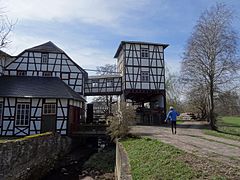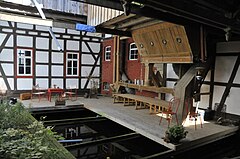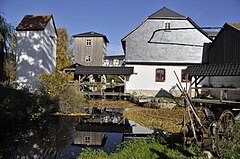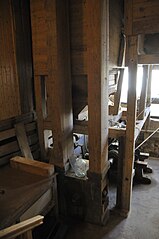Kleinhettstedt mustard mill
The art and mustard mill is an ensemble of buildings in Kleinhettstedt ( Thuringia ), a place in Stadtilm between Kranichfeld and Stadtilm.
history
Beginnings
The mill was first mentioned in the 16th century. 1620 was owned by the Junkers Sebastian of Wurmb to Heilsberg and Blankenburg and was 1,643 at the Stadtilmer Office Schösser sold Landgraf. The miller Johann Morgenroth from Teichröda bought the property on January 15, 1732 for his son Johann Friedrich. Since then, the mill has been owned by the Morgenroth family, currently in the ninth generation. There are still remnants of the wall that point to an existence from the 13th century. Johann Friedrich II. Morgenroth (1732–1781) added a cutting mill. The water power of the Ilm was used to operate the mill as a gypsum , mustard , saw and barley mill and as a spinning mill . Under Johann Friedrich III. the mill ban of the five surrounding villages was replaced by paying a transfer fee of 900 thalers . Under Johann Nicol, a cutting, mustard, plaster and oil mill were installed and the grain mill was modernized. In 1865, the company became the property of Friedrich Günter, who successfully continued the business, including pounding clover seeds. Around 1890 the cutting, gypsum and oil mills were shut down and the focus shifted to the grain mill and agriculture. The invention of the roller mill (1827) and the plansifter (1855) improved the results of industrial grain milling in such a way that a flour yield of 75-80% could be achieved. In the period from 1880 to 1990, 65 tons of grain were milled daily during the heyday, with the grain being shouldered in sacks of up to 100 kg.
electrification
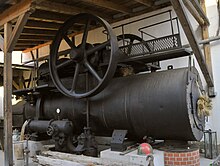
After the mill had been powered by up to five water wheels until 1892, it was converted to a locomobile from Heinrich Lanz AG in 1892 , which did its work until 1914. After that, a 110 hp diesel engine brought the necessary energy until 1947, then an electric motor that is still in use today. After the iron waterwheels were dismantled and the moats closed in 1901, a Francis turbine with 80 hp was used, which is still in service today and generates electricity. Since then, the mill in Kleinhettstedt has been able to call itself an art mill , as electrification was a major modernization and the name was given to refer to the new drive technology.
The mill was expanded several times in its history until 1914. The present building was created by the Nuremberg architect Stötzle. The construction of the rye mill and the renovation of the office were carried out in 1914. Further renovations and extensions were carried out until 1938.
VEB Mühle Drei-Gleichen-Arnstadt
In 1972 the GDR Council of Ministers decided overnight to expropriate and transfer the flourishing mill to the VEB Mühle Drei-Gleichen-Arnstadt. Dipl.-Ing. In 1980, Friedrich Morgenroth took over the position of manager of the former father's mill and began extensive modernization measures, for example with the installation of a modern rye mill. The joy of the possibility of reprivatisation after the fall of the Wall was clouded by the dependence on a few large buyers and the size of the company. The mill operation could no longer be continued economically: in 1989 the operation of the grain mill was initially stopped.
In 1990 the Treuhandanstalt made the return of the property dependent on the payment of old debts of VEB Mühle. After the "owners" at that time felt unable to do so, the mill was estimated at 250,000 DM. Since the family could not raise this amount either, the Treuhand had the rye mill and other parts of the machinery dismantled in 1991. As a result, it had to be determined that the company was too big for small customers and too small for the needs of the customers of the large mills.
New upswing from 1996
The upswing began in 1996 with the installation of holiday apartments and a ballroom. In 1998/99 commercial premises were set up in the rye mill.
Since 1999 the wheat mill has been used again as a mustard mill - from the operator's point of view, an active contribution to the preservation of monuments, as the proceeds go towards maintaining the monument ensemble. In 2001 the drive technology was completed again with a locomobile. Today (2012) the Mühlbach drives a Francis shaft turbine, which supplies a 35 kW electric motor with electricity. From here, all machines are moved using belts, some of which are meter-long. In the Mühlgraben, which was closed in 1901, a new water wheel is to be built in order to drive the mill.
Today Ulf Morgenroth runs the business, in the ninth generation since 1732.
Mustard production
The traditional mustard production can be seen in the mustard mill in Kleinhettstedt. In order to produce a high quality product, it is important to grind the mustard gently and slowly. Mustard mills that work according to the traditional wet milling process are best suited for this.
The mustard seeds used come from organic farming in Thuringia and are ground in the mill on a roller mill. Then the freshly ground mustard flour is mashed with water, vinegar and spices for hours. The finished mash is then pumped through the wet grinding stages and ground. This grinding process in particular creates a full-bodied mustard taste. The important thing is the speed of the millstones, which in Kleinhettstedt turn at only 55 / min. As a result, no heat develops, the mustard oil is retained and thus the natural heat of the spice. In contrast, industrial plants grind at over 3000 rpm, whereby the mash becomes hot and loses its aroma, taste and important ingredients, so that the sharpness has to be added later, usually with horseradish . The only preservative that is added to the mash is brandy vinegar . In the final grinding process, up to 19 different types of mustard are created by adding various spices. An average of 6.5 tons of mustard seed is processed into meal each year. The basic f is produced every two to three weeks, depending on the inventory and the order situation.
In addition to the mustard mill, a small farm shop where around twenty different mustard flavors can be tasted, and a restaurant, visitors to the facility can also visit the old grain mill. Senfmühle delivers its products throughout Germany, to the USA, Switzerland and Austria.
Impressions
Movie
- The Kleinhettstedt art mill - ... who add their mustard. Documentary, Germany, 2017, 29:45 min., Script and director: Kathrin Welzel, production: MDR , series: Der Osten - Discover where you live , first broadcast: 23 May 2017 on MDR television , synopsis by MDR, ( Memento from August 4, 2017 in the web archive archive.today ), discussion:.
Web links
- premiumsenf.de - Müller family Morgenroth
- Günter Kotte : Mustard in coffee - mustard millers in Thuringia and Saxony. ( Memento of April 8, 2017 in the Internet Archive ). In: MDR Figaro , September 19, 2015, radio essay , 23:50 min., To listen to ( download → download audio ).
swell
- Company website
- Various information boards on the company premises
- Bauernzeitung from February 22, 2013, No. 8, pp. 56-57, ZDB -ID 31302-6 , summary. ( Memento from August 5, 2017 in the Internet Archive )
Individual evidence
- ↑ Kathrin Welzel: The art mill Kleinhettstedt. ( Memento from August 4, 2017 in the archive.today web archive ). In: MDR , May 23, 2017.
- ↑ Film about the mustard mill. In: Thüringer Allgemeine , May 20, 2017.
Coordinates: 50 ° 47 '22.7 " N , 11 ° 8' 28.1" E


